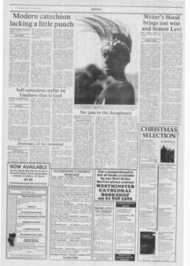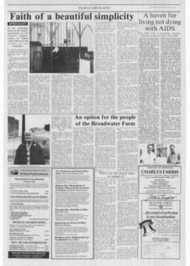Page 5, 10th November 1989
Page 5

Report an error
Noticed an error on this page?If you've noticed an error in this article please click here to report it.
Tags
Share
Related articles
Curran Fights Teaching Suspension
Curran's Ban Ends Dissent
Fr Curran Goes Back To Class
Compromise Rejected On Fr Curran's Position On Sexual Ethics
Fr Curran Dubious On Ban Reversal
Curran's creative fidelity
Fr Charles Curran (right), whose views on sexual ethics and the marriage of priests led to his 1987 suspension from teaching at the Catholic University of America, has become a cause celehre for the more liberal elements of the Catholic Church. Fr Curran, now in his second year as Visiting Professor at the University of Southern California's School of Religion, spoke to the Catholic Herald's Washington correspondent, Cristina Odone, about the
challenges facing the modern Church.
Fr Curran, the title of your most recent book, "Faithful Dissent'', seems an appropriate banner under which to fiy your theological work, Would you agree?
Yes. Catholic theological tradition has always recognised the need for what I would call a "creative fidelity". Fidelity to the scriptures, yes, but within a dynamic, "creative" framework, The Church is a living organism, and it has always stated that it is not enough to repeat — or transcribe if you wish — the scriptures as they were at the time of Jesus: no, we must understand the scriptures, appropriate them, live them in the historical context that is relevant to us.
Here then is the creative aspect: knowing how to adjust the word of the Lord to the modern day life you lead. And to a great extent, the Chtirch has been capable of adjusting. .although there is a core of teaching within the Catholic Church which remains unchanged, there are also many notions which have evolved through the centuries — the notion of personhood, for instance, is certainly different today than say at the time before, the Reformation.
This 20th century has perhaps witnessed the Church's greatest change: from the time just before the second Vatican Council, when the Church was at its most authoritarian, most centralised, to the time of the Council, when the Church began to address the question of diversity among Christians and among its followers.
Your suspension from teaching at the Catholic University of America was due . to the administration's dim view of your position on a number of ethical issues. The struggle between yourself and the University is to many Catholics representative of the tension brewing in today's Catholic
Church. Is this tension a danger to the unity of the Church?
The Church is always going to experience tension — and it always has. Tension, of course, need not be a destructive force: it can bring about a balance which can have positive influence on a community, and it can provide the sharpening of focus necessary for improvements to take place.
In my view, there are three areas in which the Church must per force experience tension. The first is the tension between past and present: the Scripture set down at the time of Jesus, and interpreted now. How does one make the book a part of daily life? How can it become a living thing?
The second area of tension within the Church is between the Church Universal and the Church particular. The tendency historically speaking has always been towards the universality of the Church. Through the use of one language — Latin — through the central authority of Rome e the Church established itself as universal. The individual in this manner, was overlooked, as was the diversity that is inherent in the followers of the Catholic Church.
And finally there has always been tension — and there always will be — between the authority and the truth. . here of course we think of the question of infallibility, which throughout the centuries has returned at the centre of arguments and at the core of many Catholics' doubts.
Unfortunately, today these tensions are more exacerbated than they need be. This is because the change of policy that the second Vatican Council brought about was not accompanied by a comparable change in structure. If we examine the New Code of Canon Law that came out in 1983, for instance, we see that it yielded no effective change in the key role of the bishops: they act
as papal advisers, their conferences of bishops are less important than they ought to be, and their dialogue with the people (and with Rome) is not as open as it ought to be. Tensions have mounted also because the Church has become more centralised in the 20th century — improved communications and transport have buttressed this centralisation. With a 'phone call, Rome can monitor the goings-on of a parish half a world away. Take the English Catholic community — how much did it feel under papal authority in the last few centuries? Very little: the Pope was far away in Rome. Now this is no longer true. Finally. the inflation of noninfallible church teaching has also given rise to severe tensions. Matters such as birth control. married priests — at a grassrOOt level they are felt very strongly. When the people turn to their Church for guidance on these matters, however, what do they hear but a litany of restrictions that are not infallible pronouncements?
Much of the Catholic wade looks to the American Church as a very vibrant, "living" Church. Would you agree with this perception?"
I'm not sure I see the American Church as very vibrant. At present there is a very palpable sense of disenchantment, but what this will lead to 1 don't know. There is certainly a great degree of wariness vis a vis Rome on behalf of many
American Catholics — both among Church "professionals" and Catholic laymen and women.
There is no doubt that because the US is so large, and the Catholic Church within it so sizeable, the Pope wants to keep a close watch on its clergy. The number of investigations prove this — on women religious, on seminaries, on Archbishop Hunthausen of Seattle. Rome is very concerned as to what takes place here and certainly it is prepared to take steps — as was true in my case, as was true in Archbishop Hunthausen's case. Having said this, I feel that at a parish level, Rome still impinges very little on the Catholic American. For parishioners, their local priest, their parish activities arc the Church. Which is the way it should he.
Rome unfortunately does impinge on what we call the "middle management and low middle management" positions within the church hierarchy: and these are the groups that are beginning to voice disenchantment.
The women religious have for years now taken a strong stand on those issues where they disagree with Rome. It may well be in fact that the most crucial role in the Church of' the 1990s will be played by women religious: the issue of their ministry is certainly already a key issue. And many are taking radical steps vis a vis this issue. I see many of my own female students who feel the call to minister leaving the Church.
1 also believe that it is critical for American bishops to open a more direct dialogue with Rome. The collegial spirit which begins and ends with the bishops must be strengthened and this can only occur if the bishops as a group stand up and say to the Pope: "Holy Father we venerate you, we love you, but on this issue we disagree with you." Sadly, I am not sure thc time is ripe for this.
Is the Church capable of renewal, and is such a renewal the prescription for a living Catholic Church?
Yes the Church has always shown itself strong enough to bear the brunt often accompanying renewal efforts. And certainly today's Church needs renewal. The problem is how to take skps, and in which direction? For, since before the second Vatican Council we had had two trends of theologiea thought competing for prominence.
The "progressives" — Kung, for instance — who embrace a Thomist view of the world, and are more positive about man and his abilities. This school of thought welcomes change and indeed wants to promote it. They believe in the Church's dynamic nature, and believe that this is its strength.
At the other pole of thinking we have the "conservatives", like Cardinal Joseph Rat zinger. Here we have a body of early church historians who see man in rather a negative light, and see the changes operated by the Council as uncomfortable. unnecessary. Which of these two schools of thought will succeed in affecting a change remains to be seen.
The past few years have witnessed a growing conservatism among Catholic youth in several countries — Spain's Opus Dei, Italy's Comunione Liberazione. The movement finds a parallel in the spread of fundamentalist Christianity among the young in this country. How do. you view this development?
I see this movement among young Americans who seek certitude, seek security because there is none in their lives. For the first time since the birth of this nation, there will be a generation that will not he able to look back to their parents' and say I have it better than they did. And this frightens young People and makes them seek solace in religion.
What they want, ironically, is the very structure and backbone that the Church had before Vatican II. lt seems this new movement is bringing people away from consumerist values — which is a good thing — but sometimes towards a more narrow view of things — which is a bad thing.
How it will develop, I am not sure. However, what is certain is that this trend is highlighting the challenge that faces us, us the Catholic Church of today: hope, the Gospel told us, is something you do not see hut that you must work for. Hope makes the Gospel liveable.
blog comments powered by Disqus











